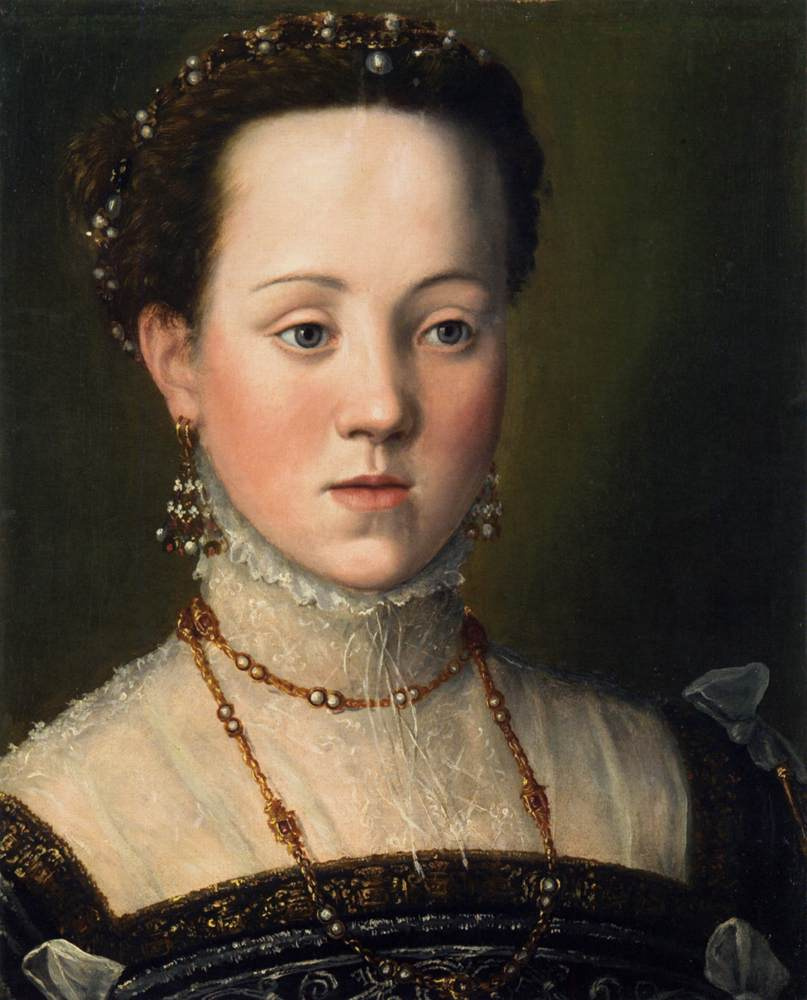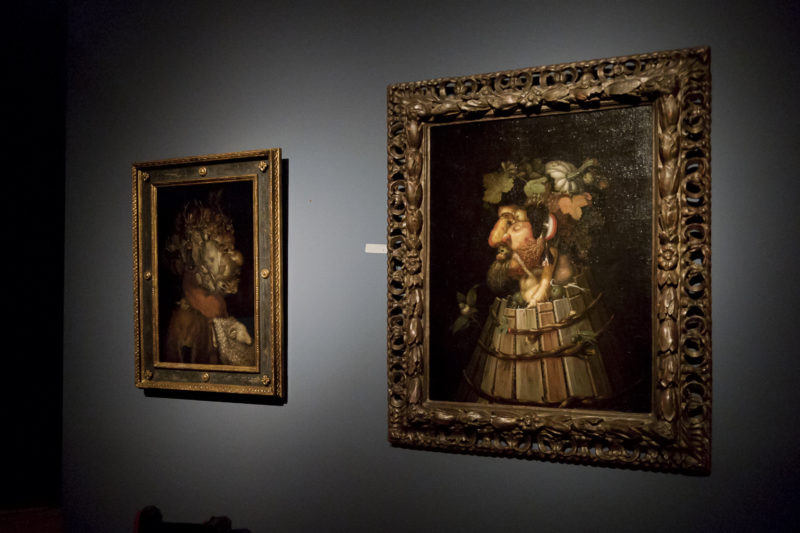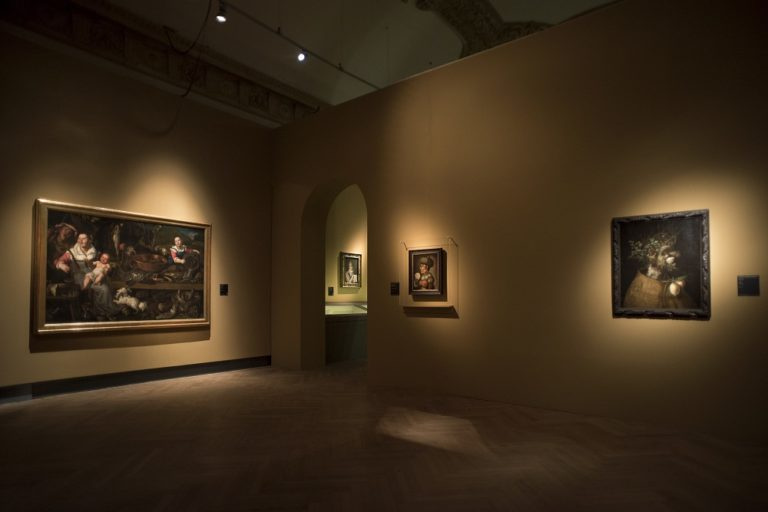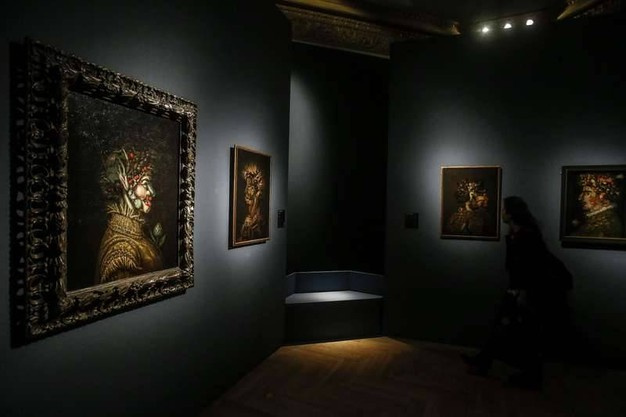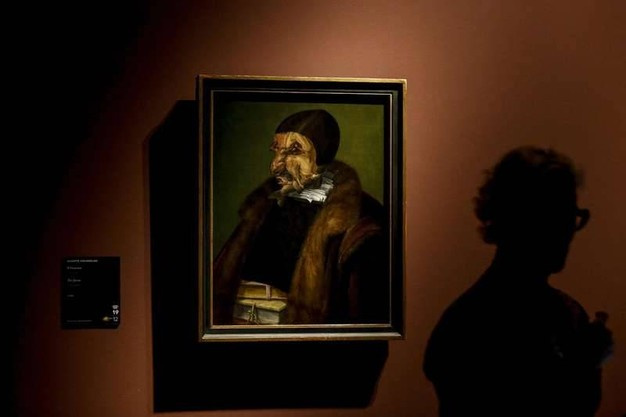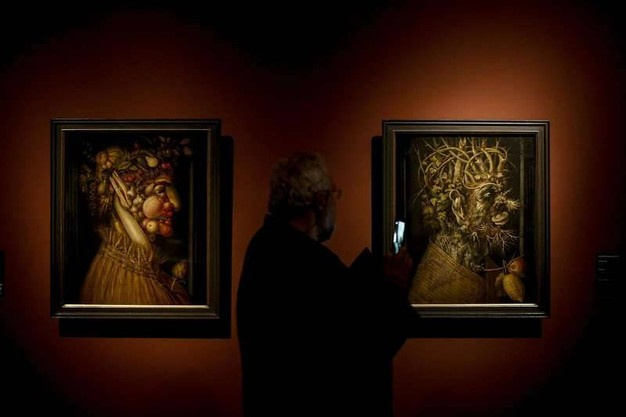A comprehensive exhibition of Giuseppe Arcimboldo is now on view at Palazzo Barberini in Rome. Apparently, it is the largest exhibition of this outstanding artist in the last few decades, organized by the National Galleries of Ancient Art of Rome.
Retrospective "Arcimboldo" for the first time represents more than 70 works of one of the main Mannerist artists. It’s the unique opportunity to see his great autograph masterpieces, the famous allegories by Giuseppe Arcimboldo, called the predecessor of Surrealism.
Retrospective "Arcimboldo" for the first time represents more than 70 works of one of the main Mannerist artists. It’s the unique opportunity to see his great autograph masterpieces, the famous allegories by Giuseppe Arcimboldo, called the predecessor of Surrealism.

Newly discovered in 1930-s, "ridiculous paintings" by Arcimboldo became cult to Dadaists and Surrealists.
Divided into six sections, the exhibition opens with an introductory room showing the famous paper self-portrait, where Arcimboldo positions himself as a scientist, philosopher and inventor in the Milanese environment of the scholars and humanists (Giovanni Paolo Lomazzo, Paolo Morigia, Gregorio Comanini), who were promoters and speakers of the artist’s fame.

Giuseppe Arcimboldi, known as Arcimboldo (1526 or 1527 — July 11, 1593) was an Italian painter, author of the "composite heads" of fruits, flowers, vegetables, fish and books. Arcimboldo was formed at the father’s shop, as part of Leonardo’s followers. Esoteric and alchemical, he considered himself a poet and philosopher, engineer and inventor.
In 1562, he became court portraitist to Ferdinand I at the Habsburg court in Vienna, Austria and later, to Maximilian II and his son Rudolf II at the court in Prague. He was also the court decorator and costume designer.
Left: Self-portrait, now in National Gallery in Prague.
In 1562, he became court portraitist to Ferdinand I at the Habsburg court in Vienna, Austria and later, to Maximilian II and his son Rudolf II at the court in Prague. He was also the court decorator and costume designer.
Left: Self-portrait, now in National Gallery in Prague.
The exhibition can boast of the artist’s most famous masterpieces — from Seasons to Elements, from The Librarian to The Jurists, from Priapo (Ortolano) to The Chef. His portraits and precious watercolored drawings of rides and fountains are in dialogue with paintings and the arcimoldesche copies, in addition to a series of objects from the famous imperial wunderkammer, the numismatic shops of Milan.

At a distance, his portraits looked like normal human portraits. However, individual objects in each portrait were actually overlapped together to make various anatomical shapes of a human. They were carefully constructed by his imagination. The assembled objects in each portrait were not random: each was related by characterization.
In the portrait now represented by several copies called The Librarian, Arcimboldo used objects that signified the book culture at that time, such as the curtain that created individual study rooms in a library.
Left: Giuseppe Arcimboldo. The Librarian (circa 1566), Skokloster Castle, Sweden.
In the portrait now represented by several copies called The Librarian, Arcimboldo used objects that signified the book culture at that time, such as the curtain that created individual study rooms in a library.
Left: Giuseppe Arcimboldo. The Librarian (circa 1566), Skokloster Castle, Sweden.
Art historians think that Arcimboldo criticized rich people’s misbehavior. He considered that wealthy people collected books only to own them, rather than to read them.
Arcimboldo’s conventional work on traditional religious subjects, has fallen into oblivion, but his portraits of human heads made up of vegetables, plants, fruits, sea creatures and tree roots, were greatly admired by his contemporaries and remain a source of fascination today.
Augustus, Elector of Saxony, who visited Vienna in 1570 and 1573, saw Arcimboldo’s work and commissioned a copy of his The Four Seasons which incorporates his own monarchic symbols.
Augustus, Elector of Saxony, who visited Vienna in 1570 and 1573, saw Arcimboldo’s work and commissioned a copy of his The Four Seasons which incorporates his own monarchic symbols.
4 seasons. Winter. The first series
1563, 66.7×50.5 cm
Art critics debate whether his paintings were whimsical or the product of a deranged mind. A majority of scholars hold to the view, however, that given the Renaissance
fascination with riddles, puzzles, and the bizarre (see, for example, the grotesque heads of Leonardo da Vinci), Arcimboldo, far from being mentally imbalanced, catered to the taste of his times.
Arcimboldo died in Milan, where he had retired after leaving the Prague service. It was during this last phase of his career that he produced the composite portrait of Rudolph II, as well as his self-portrait as the Four Seasons.
Arcimboldo died in Milan, where he had retired after leaving the Prague service. It was during this last phase of his career that he produced the composite portrait of Rudolph II, as well as his self-portrait as the Four Seasons.
Now paintings by Giuseppe Arcimboldo can be found in the museums of Vienna, Innsbruck and Madrid, in the Louvre in Paris and the Uffizi Gallery, Florence, in Sweden and the USA.

Exhibition "Arcimboldo" in Palazzo Barberini, Rome. Photos via euroma2. it
The itinerary starts with a section dedicated to the Milanese environment in which Arcimboldo grew up, before going on to examine the period spent in Vienna and Prague as portrait painter to the Habsburg court. This section features the portrait of the Archduchess Anna, studies for parties and the subsequent personification of the four seasons in a dialogue with the four elements.
Archduchess Anna, daughter of Emperor Maximilian II
1563, 42.7×34.1 cm
The work is on show for the first time in at least 20 years. Moving along the exhibition halls you can see the so-called reversible heads, ambiguous still life images that look totally different if rotated 180 degrees.
"The artworks in fact represent 'a very serious rhetorical game, a sort of engagement with the visitor’s intellect", explains the director of the National Galleries of Ancient Art in Rome, Flaminia Gennari Santori.
The fifth section — Beautiful compound — shows real iconic paradoxes and analyzes the method of the composite in various cultural contexts. And the last section "Ridiculous paints" concludes the exhibition: Arcimboldo was a master of play and irony, continuing the Leonardesque and Lombard tradition of caricature, as in the personifications of crafts. One may also find masterpieces like Il Giurista e Il Librotecario on show.
Retrospective "Arcimboldo" in Palazzo Barberini will last until February 11, 2018.
Based on the official site of Palazzo Barberini, Ansa. it, www.barberinicorsini.org and others.







